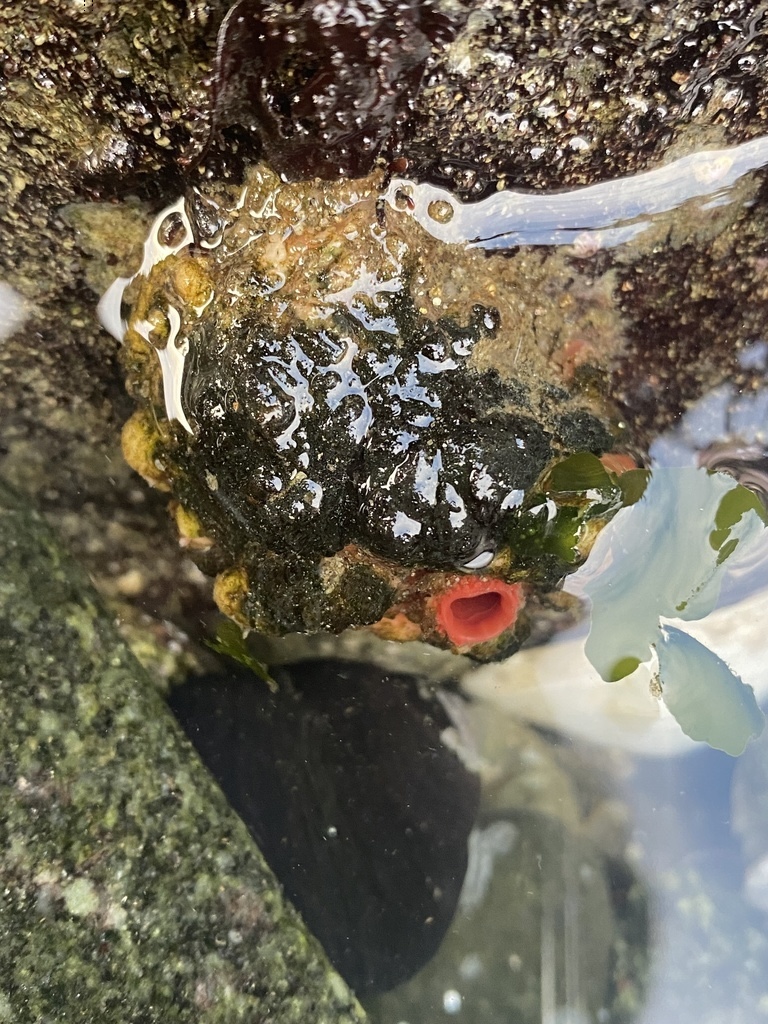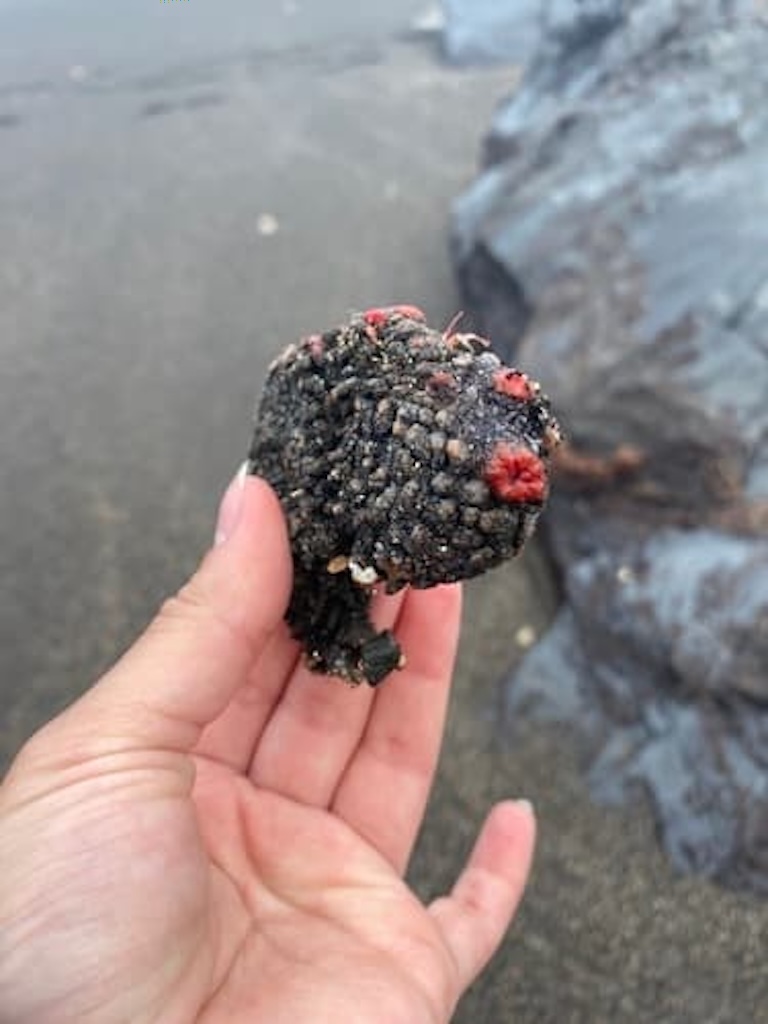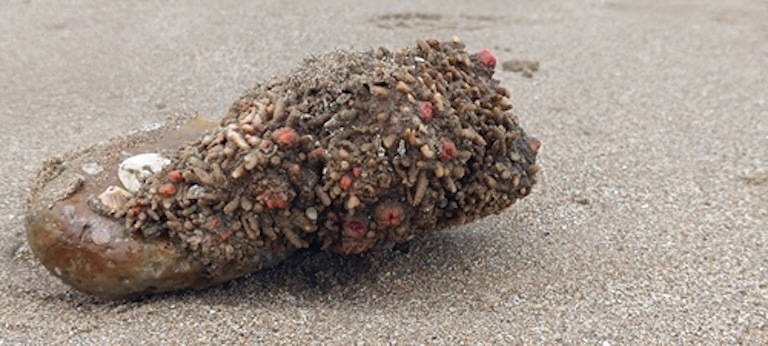Pyura Chilensis Profile
Sea squirts don’t sound tasty, even when you put edible in front of their name, and when they look like a blood clot inside a rock, it doesn’t make things any more appetising.
But around the Chilean coast, there’s an edible sea squirt just like this, and to prepare it, fishermen pull off the ‘tits’. Apparently, it has a bitter, soapy taste, and can be eaten raw. But why you’d want to, remains a mystery.

Pyura Chilensis Facts Overview
| Habitat: | Intertidal and subtidal marine |
| Location: | Pacific South America |
| Lifespan: | Unknown |
| Size: | Up to around 15 cm across |
| Weight: | Up to 112g |
| Colour: | Grey/brown outside, red inside |
| Diet: | Filter feeders |
| Predators: | Otters, snails, starfish, humans |
| Top Speed: | Sessile |
| No. of Species: | 1 |
| Conservation Status: | Not Listed (IUCN) |
Pyura chilensis, or Piure, as it’s known locally, is a tunicate that fixes itself to the bottom of the sea and sits there siphoning nutrients out of the water, minding its own business until some leathery dude with a knife comes and pulls its tits off.
But more interestingly, they’re our distant relatives, closer to us than they are to many of the animals they resemble, and with that comes some curious similarities, and some potential lessons about our own biology.
Interesting Pyura Chilensis Facts
1. They’re chordates
It might be interesting to learn that you have more in common with a tunicate like Pyura chilensis than they do with other soft-bodied animals like oysters and jellyfish.
Chordates are defined by the presence of a notochord, which is essentially a proto-spine that in vertebrates develops into a true vertebral column.
Tunicates don’t have a spine, but the presence of this notochord, along with a handful of other shared characteristics, or synapomorphies, shows us that these squishy little goo rocks are actually distant relatives of ours that we haven’t stayed in contact with.
Back in the day (we’re talking more than half a billion years ago) everything lived in the ocean, and everything was squishy.
Predation hadn’t been invented so shells and protective spines weren’t really all that fashionable. But squishy things don’t fossilize well, so the data around when exactly all this happened is still a bit loose.
Regardless, at some point, long ago, a tunicate-like common ancestor spawned a sister group: the vertebrates. That means, all the fish, birds, donkeys and that annoying kid on the bus came from a squishy mass in the bottom of the ocean.

2. Their siphons are made of hearts
One of the recognisable features of tunicates lies in their tissues. Like bivalves and cephalopods, tunicates have a siphon, which are muscular barrels that pull water in and push it out.
These are used for respiration and for filter feeding, but what’s interesting is that they’re made of cardiac muscle – the same muscle you find in the heart of vertebrates.
This feature is present in fossils from over 500 million years ago and is likely what vertebrate hearts evolved from, growing more complex and internalized over time.
3. They have vanadium blood
Their weird hearts have weird blood moving through them, which is clear to light green, and filled with a baffling amount of vanadium.
Vanadium is a transition metal found in almost every living thing, and its biological function isn’t well understood, but to find it in a tunicate isn’t strange.
What is strange is just how much of it there is. The blood of P. chilensis can contain ten million times the concentration of vanadium as the surrounding water, demonstrating a sequestering phenomenon that we have no idea the reason for.
4. They can reverse their heartbeats
Along with these large siphons, Pyura chilensis has a barrel-shaped heart that pulls and pushes light green blood around for reasons nobody has yet figured out.
But another mystery around this animal’s circulatory system is why, periodically, the heat will stop beating for a while and then change direction.
There’s no current explanation for this mechanism, and it’s one of the coolest biological mysteries to solve. It’s almost akin to the breathing that land vertebrates take, even down to the inspiratory pause between breaths. 1
5. They’re filter feeders
These siphons, known to local fishermen as “tits” for some reason, are inlets and outlets for seawater and will bring in nutritional organic matter and plankton from the water and expel the spent water out again.
While some tunicates spend a significant part of their lives swimming about like tadpoles, this one sits affixed to the rocks within 24 hours of spawning, growing into a rock-like animal, and forming vast fields of thousands of conspecifics.
But not always.
6. They’re born male
These strange little chordates begin life with male gonads. Then, as they age, they gain a female set, becoming hermaphroditic.
This allows incels to procreate with themselves, in the cases where they’ve landed on a rock and there are no other Piures about.
Usually, they form large groups of thousands, but sometimes there can be just a handful. Other times, it’s just one lonely tunicate, who has to engage in a reproductive strategy called “selfing”.
In humans, selfing – as fun as it is – is not a valid way to make babies, but in these guys, they have both sperm and eggs and will shower their surroundings with both in a glorious cloud of sperm-egg collisions. 2
7. They can regenerate their CNS
The trouble with treating conditions after they arise is that the damage is already done. If we get cut, we don’t regenerate, we scar.
And this new tissue is just a close approximation of what was once there. That’s fine when you only have a paper cut, but when the heart scars from an attack, that damage stays and continues to threaten people’s lives, even once it’s been ‘fixed’.
Human-based medicine is woefully reactive, and while there are many who are loudly championing the benefits of preventative treatment as a cheaper and superior alternative, what if – even better – we could regenerate damaged tissues?
Regenerative treatment is the cold fusion of medicine: a holy grail that could change the course of human history for the better, and animals like Pyura chilensis are helping it along.
They have the ability to regenerate their central nervous systems, and since they share a lot of genes with us, they might be able to teach researchers how to do it. 3

Pyura Chilensis Fact-File Summary
Scientific Classification
| Kingdom: | Animalia |
| Phylum: | Chordata |
| Class: | Tunicata |
| Order: | Stolidbranchia |
| Family: | Pyuridae |
| Genus | Pyura |
| Species: | chilensis |
Fact Sources & References
- Bocas Research Station (2012), “Heart beat reversal in Tunicates”, YouTube.
- Patricio H. Manríquez (2005), “Self-fertilization as an alternative mode of reproduction in the solitary tunicate Pyura chilensis”, Inter-Research Science Publisher.
- Isadora Abreu (2022), “Central nervous system regeneration in ascidians: cell migration and differentiation”, Research Gate.
